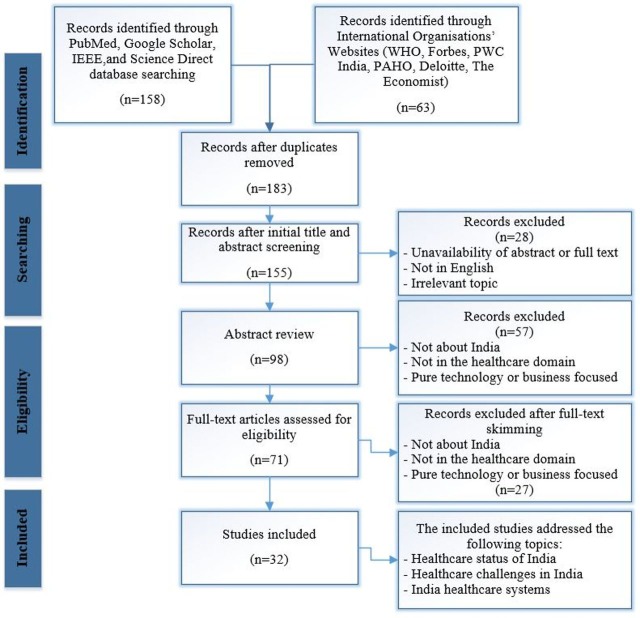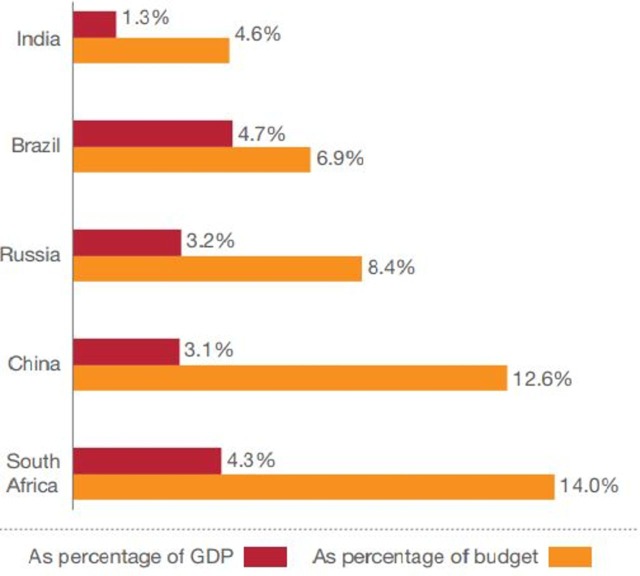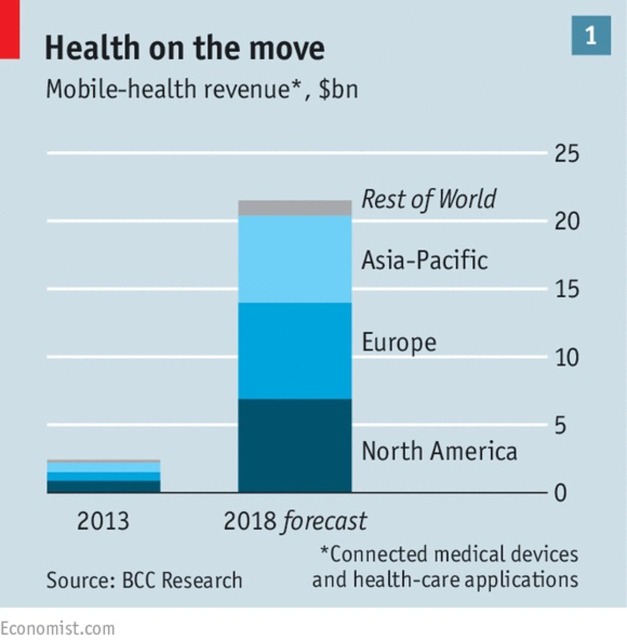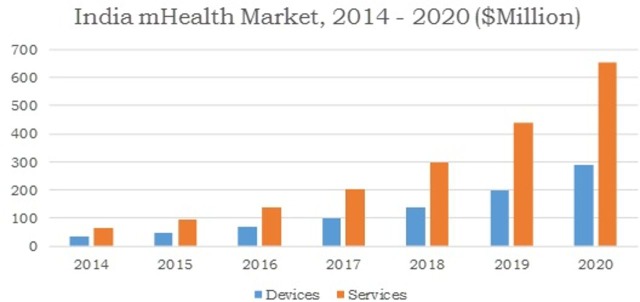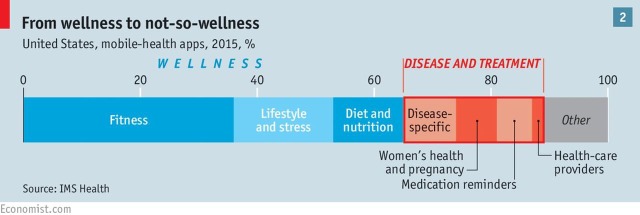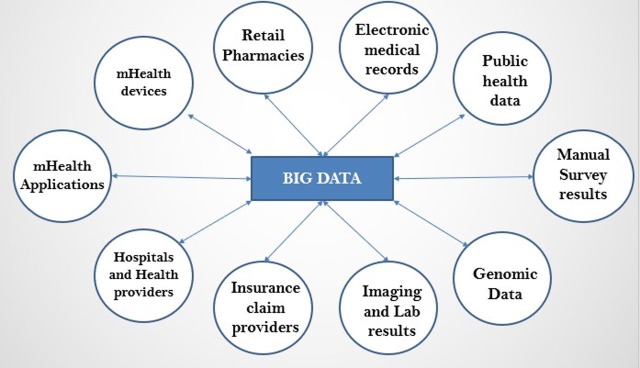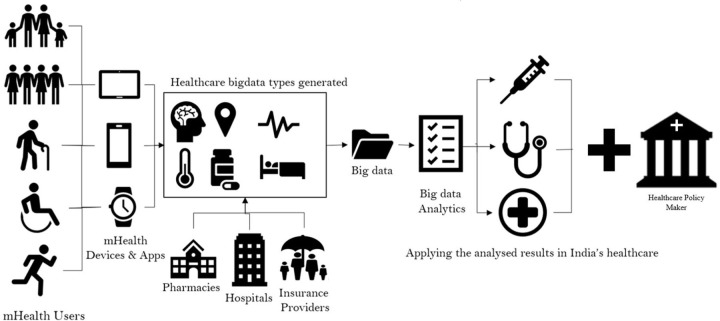Abstract
Background
The use of mobile devices in health (mobile health/mHealth) coupled with related technologies promises to transform global health delivery by creating new delivery models that can be integrated with existing health services. These delivery models could facilitate healthcare delivery into rural areas where there is limited access to high-quality access care. Mobile technologies, Internet of Things and 5G connectivity may hold the key to supporting increased velocity, variety and volume of healthcare data.
Objective
The purpose of this study is to identify and analyse challenges related to the current status of India’s healthcare system—with a specific focus on mHealth and big-data analytics technologies. To address these challenges, a framework is proposed for integrating the generated mHealth big-data and applying the results in India's healthcare.
Method
A critical review was conducted using electronic sources between December 2018 and February 2019, limited to English language articles and reports published from 2010 onwards.
Main outcome
This paper describes trending relationships in mHealth with big-data as well as the accessibility of national opportunities when specific barriers and constraints are overcome. The paper concentrates on the healthcare delivery problems faced by rural and low-income communities in India to illustrate more general aspects and identify key issues. A model is proposed that utilises generated data from mHealth devices for big-data analysis that could result in providing insights into the India population health status. The insights could be important for public health planning by the government towards reaching the Universal Health Coverage.
Conclusion
Biomedical, behavioural and lifestyle data from individuals may enable customised and improved healthcare services to be delivered. The analysis of data from mHealth devices can reveal new knowledge to effectively and efficiently support national healthcare demands in less developed nations, without fully accessible healthcare systems.
Keywords: mHealth, Big-Data, Healthcare, Big-data Analytics, IoT
Introduction
Healthcare challenges are arguably the most significant barriers to sustainable global development and are magnified by various socioeconomic problems and resource inadequacies. Limited access to healthcare creates a major barrier to enduring social and economic development across the globe.1 In all, 400 million individuals had no access to any form of basic healthcare2 while two billion people do not have access to required medications.3 Therefore, more than one-fourth of the world population has unmet health needs. This leaves the global community with the challenge of how to support a significant number of the world’s populace still lacking in access to basic prescription medications along with the ever-increasing healthcare costs faced by society.3 In this regard, the WHO introduced the concept of Universal Health Coverage (UHC) as the theme for World Health Day 2018— healthcare for everyone and everywhere.4 The aim is to provide everyone with access to basic healthcare services.5 However, financial constraints within systems and factors like aged-population-related chronic diseases6 can affect the availability, accessibility and quality of care. Several healthcare challenges could be mitigated and their adverse impacts reduced by employing appropriate and emerging technologies.7
India has one of the largest rural communities in the world and studies show that improvements with new innovations are required in their healthcare system.8 This research proposes a conceptual model that can process generated data from mobile devices to provide insights for the formulation of healthcare policies for India’s rural communities.
The research investigates mobile health (mHealth) and big-data analytics technologies to provide insights to governments and organisations to enable well-informed decisions on efficient policy planning, use of resources and to address specific health challenges and regional needs. Furthermore, insight into opportunities in the fields of mHealth and big-data and their integration to improve healthcare service is undertaken specifically in rural India. Data from mHealth devices can be analysed with powerful algorithms to extract healthcare information from communities which could reveal specific and vital communal healthcare needs that have hitherto being overlooked.
In specific terms, this study is set out with the following objectives.
Review healthcare challenges in India, their context and investigate its current status—with a specific focus on mHealth.
Identify opportunities in Indian healthcare system for deploying mHealth and big-data
Propose a mHealth model and provide recommendations for its efficient use to improve healthcare and action policies by authorities.
Methods
A critical review was undertaken (from December 2018 to February 2019) to understand India’s healthcare system and the challenges that face implementation of the commitment towards achieving UHC. This review also identified mHealth opportunities in the India healthcare system. The review was limited to English articles and reports from 2010 to present date. The databases used were as follows: PubMed, Google Scholar, IEEEXplore and ScienceDirect. Moreover, other sources used were reports from WHO, Forbes, the Economist, PWC, Pan American Health Organisation, International Telecommunication Union and Deloitte (figure 1). Search terms included India healthcare systems, challenges, opportunities, status and mHealth opportunities.
Figure 1.
The critical review process.
India healthcare system and challenges
Alongside the global healthcare challenges, Indian healthcare faces particular issues, including inadequate healthcare resources, insufficient funding, poor healthcare infrastructure and rural–urban disparity.9 The total healthcare budget of the Indian government is low (4.7% of gross domestic product), considering the population; therefore, Indians pay more than 62% of their health expenses from their personal savings.10 In this regard, India is far behind compared with the other emerging economies8 (figure 2).
Figure 2.
Emerging economies healthcare expenditure.
India faces particular challenges in terms of inequalities in access to healthcare.11 For every 2046 people in India, there is only one bed in government hospitals and one government doctor for every 10 189 individuals. More than 86% of hospital visits take place in rural areas and most of which need to travel a long distance to access hospital. The number of doctors, nurses and health workers are low in comparison to the high population in certain regions. The majority of healthcare professionals are focused in and around urban regions (60% of hospitals and 80% of doctors), so rural health lacks more than 3000 doctors.9 10 In rural India, certified practitioners are few; a WHO report stated that 31.4% of those who call themselves allopathic doctors are only qualified up to Class 12% and 57.3% of doctors did not have a medical qualification.12
Nevertheless, technology utilisation, in particular mHealth and big-data analytics, may make healthcare more affordable, available and accessible for wider communities; so India healthcare system could benefit from modern technologies.11
mHealth and its applications
In developing countries, the uptake and use of mobile phones have skipped over infrastructure inadequacies that have led to positive changes in many sectors including healthcare. Mobile devices and communications promote the development of emerging systems and applications for healthcare13 called mHealth that includes the integration of mobile computing, medical sensors and portable devices. mHealth scope is broader than just mobile and smartphones, and other smart technologies can be used in accordance with the mHealth including wearables devices, implants, location-based trackers and sensors for legacy devices.8 mHealth tries to explore the advances in wireless communication, ubiquitous computing and ‘wearable’ devices technologies in healthcare to extend community health support and reach into rural areas.14 15 mHealth devices can capture, store, retrieve and transmit data to provide instantaneous, personalised informatics for individuals. mHealth could be a key element in healthcare systems16 and can be useful in monitoring health status and improving patient safety and quality of care. mHealth is becoming more popular in the smart device sector as it can provide remote assistance and data collection. Unlike an individual healthcare service, the collected data can be expanded and used across communities to understand common trends and thus, improve the standards of healthcare.17 mHealth can provide support in vulnerable and remote communities via improvements to networks and the emergence of Internet of Things (IoT).18
The use of mobile technologies and their impact is likely to increase in the coming years. Surveys showed that mobile technologies and devices held about 80% of the overall global market in 2017, whereas in 2013, it was just 39%.19 The global number of users of smart mobile devices is anticipated to almost double in 2020 compared with 2014 and reach 2.87 billion users.20 This may increase the significance of mHealth globally, as low-cost smartphones have the required features and capabilities to cope with health-related applications and include the necessary connectivity.21
As the popularity of mHealth increases, countries are allotting more funding to this area22 (figure 3), helping society and communities to become more health literate.16 23 This promotes wellness rather than expensive medical intervention and hospitalisation.
Figure 3.
Global mHealth market.
Integrating mHealth into the India healthcare system mHealth can create new opportunities for healthcare, especially in resource-poor environments where healthcare systems have limitations in terms of infrastructure, expertise and human resources.23 mHealth could play a key role in Indian healthcare, especially for rural communities whose access to healthcare could be limited. For these communities, mHealth could facilitate access to basic health services and the analysis of it generate data may be useful for shaping the healthcare demands.
India may be able to gain particular benefit from mHealth because of the following factors:
In rural areas of India, there is a lack of healthcare resources and access and people struggle to get proper and timely healthcare services. As India’s population lies predominantly in rural areas, the need for a new system to address their healthcare requirements is essential; therefore, mHealth could be a relief for this situation.
In India, due to the cost reduction of the mobile handsets and expansion of their network coverage, the number of mobile subscribers has risen to over 1 billion16 or 86.8% of the population by 201824 out of which 42% are living in rural areas and almost half of them had a smartphone.16 In these areas, the key driver to increase internet penetration has been the availability of low-cost internet-enabled devices.25
The majority of Indians, including illiterate and low-income population, have access to mobile phones and are familiar with their functions.25 More than 86% of 15-year to 24-year-old people, and around 70% of the people above 15 years old are literate.26 The literacy rate among senior citizens has gradually increased since 2005 and has reached to almost 58%. Also, within the next few years, smartphones will become affordable for illiterate people in developing countries.27 Recently, there has also been work to develop mHealth applications that are usable by people with low literacy.28 29
The number of healthcare-related applications is growing exponentially and now exceeds 165 000 in the global market.30 In India, in 2014, mHealth devices and services together consumed $50 million of market share where it is expected to grow steadily to reach $650 million by 202031 (figure 4).
Figure 4.
Indian mHealth market.
These factors may encourage the growth of mHealth that can potentially boost and leverage a number of public health initiatives for healthcare delivery.16 There is a growing range of healthcare-related applications promised by mHealth for mobile users22 (figure 5) that may increase mHealth acceptance and use. mHealth has evolved from simply maintaining a healthy lifestyle (eg, fitness trackers) to disease and treatment (eg, medication reminders). In India, mHealth services began as fitness applications which have expanded to doctor appointments, diagnostics, preventive care and medical service search while monitoring may have a dominant market share in future.32
Figure 5.
Mhealth applications for healthcare.
Big-data utilisation and emerging trends in healthcare
Previously, a considerable amount of health data is not used due to difficulties in data management, evaluation and analysis, and they are often remained siloed. However, as healthcare is moving towards evidence-based medicine globally, having a continuous systematic review of clinical data is necessary for effective and efficient decision-making. This requires high accuracy in operations and decision-making while time is a vital factor. Therefore, increased use of health data may be an important way to improve efficiency and effectiveness in the sector. Having access to patients’ records is necessary for physicians to support their diagnosis and monitor patients’ condition. However, collecting, maintaining and analysing each single patient’s healthcare background in a timely manner is a challenging task.
Health data may come from many different sources and in various forms. This volume and variety of data require analysis via big-data algorithmic and machine learning (ML) systems. These systems have the capability to aggregate data from different sources that could provide robust evidences for healthcare purposes33 and can be drivers for intelligent healthcare.34
The source of big-data can include the internet, smartphones, IoT or sensor and mobile devices. Through big-data analysis, meaningful trends and information can be extracted and turned into invaluable insights and knowledge acquisition. Innovations in ML are helping high-dimensional big-data informatics influence and transform the current healthcare industry with a multitude of new initiatives. Currently, deep learning and ML tools are available for big-data processing of health informatics such as neural networks techniques that are revolutionising bioinformatics, medical imaging, public health and pervasive sensing.35
mHealth, big-data integration and initiatives
Big-data and mHealth have a mutual relation and to get the optimum benefits of mHealth they need to work as integrated tools.16 As the volume and variation of monitored health data are high, the utilisation of the mHealth and big-data will make it easier to study, monitor and understand patients’ health status. Data from m-health devices and big-data analysis can empower healthcare institutions, providing a more holistic, patient-centric approach by concentrating on quality of treatment while balancing pressures on healthcare spending and cost.33 This is based on transforming mHealth data into meaningful information and could benefit clinicians and patients.34 The real power of these data is not just individual insights, but the effect of leveraging the collective knowledge that can be realised through big-data analysis and ML algorithms; the results could lead to intelligent automation within the health sector such as automatic disease outbreak identification.
mHealth devices can detect and monitor different human body’s parameters including health vital signs, and electrocardiography and recently hypertension and hypotension levels.36 Analysing these data provide insightful individual health patterns, thus monitoring these parameters support delivery of proper and customised care. They can also join in the big-data cluster including other clinical data; therefore, in emergency situations, physicians or emergency response team can act swiftly. The continuous update of patients’ data and regular updates to physicians can also reduce the risk of healthcare errors, improve safety and avoid unsuitable care. This information can help the individual to give adequate instructions or even medical prescriptions for their conditions. This method of treatment is particularly helpful with chronic diseases which need continuous monitoring such as diabetes and asthma. Prescribing medicines and predicting diseases could be easier for doctors with the advent of mHealth big-data. This could help to analyse common diseases in an area and help in surveillance of epidemics and in the response and taking necessary precautions at the right time before the disease spreads more. Authorities can detect any emergencies or critical situations and avail the proper care at the right time. Such initiatives have been implemented in Senegal.37
Advances in big-data analytics and applications using ML algorithms are helping to unify fledgling and promising initiatives. These benefits are not confirmed to low-infrastructure environments. In New Zealand, technology uptake is relatively high. Digital and virtual health approaches are seen as playing an increasingly important role in patient interaction, especially in remote regions.38 Although they are not without challenges, but they may increase healthcare service coverage to remote areas at a lower cost. Currently, such schemes are linked to specific initiatives, population groups or health conditions. For example, MAiHEALTH provides mobile and virtual medical centre in rural Patea.38 In Auckland, mHealth devices are supporting child health in lower socio-economic regions with the iMoko. In iMoko, teacher aides perform basic health assessments, store in the cloud and send to central digital health teams; this team can quickly assess the information, clinician approves treatment plan and prescriptions are sent to parents or caregivers.39 With this collected information, the pattern of disease can be extracted and then taught to digital health assessors. This may reduce emergency visits and hospitalisations.
Big-data and mHealth integration for the India healthcare system
Indian healthcare does not currently use technology extensively40 while implementing new approaches may be most significant in the rural areas of India where healthcare infrastructure and resources are not as readily available. Potentially, mHealth devices combined with big-data could increase rural health and enhance healthcare systems to be more efficient, cheaper, and more importantly available to a wider community, as needed by UHC and helps India to move towards UHC-based health system.
Data can be collected from different potential sources (figure 6) and transmitted to cloud-based platforms or servers to store as a big-data repository and then thanks to the diversity of the health data sources, different applications can be offered to enhance healthcare delivery. These data are related to the health condition of an individual. The aim is to differentiate specific information from this bulk amount of big-data for greater understanding of patient data, health status and with the timely symptom identification.
Figure 6.
Big-data generated from India’s mHealth system.
Continuous monitoring and updating the patient’s data coupled with regular updates to physicians can help them to identify unexpected complications such as heart attack and stroke. If there is an epidemic in rural areas of India, generated big-data from mHealth devices can help identify its extent and rate of growth. In such cases, the high rise of specific diseases or related symptoms (eg, high fever) may reveal a spread of communicable disease (eg, influenza) and help practitioners to react timely and appropriately. Through this analysis, authorities or the government can implement specific precautions, or even establish necessary facilities to avoid healthcare issues before the situation gets serious. Therefore, the government can take the situation under control at an early stage and reduce the impact of the epidemic.
People living in rural regions can get updated news and awareness of diseases and can provide required vaccines and preventive medicines before the disease spreads more. Furthermore, the analysis of big-data can even be helpful in monitoring the needs or the health conditions of an individual or a region based on available data that is held in mHealth big-data repositories. The applications of such evaluated and analysed data are massive as the information brings out more and more knowledge about an area or a person.
Figure 7 illustrates the complete procedure that can be used to improve the situation in healthcare from mHealth users, to mHealth devices and applications to types of healthcare data are collected. In addition, the data are collected from the hospitals, pharmacies and insurance providers. Results in a big-data analysis using Hadoop software can determine different needs in India’s healthcare systems.
Figure 7.
Generated mHealth big-data and applying results in India's healthcare.
Discussion and conclusion
Mobile phones/devices are one of the most common tools used by majority of people even who are illiterates27 or low income.25 Therefore, they are one of the most available, accessible and cheap tools for data collection including healthcare data. Therefore, their usage in healthcare has become strategic for healthcare development in low-income and/or middle-income countries and they have been used for different purposes such as patient monitoring, health survey, epidemiological surveillance and public health awareness.37 mHealth in India can be a scenario changer due to the massive government thrust towards digitising India25 and achieving UHC.4 Therefore, it is believed that the proposed model (figure 7) can be applied in the India healthcare system to support:
Emergency response services: to deliver care and medication at the right time through automatic or manual alert to authorities from mHealth devices.
Healthcare monitoring: monitoring and analysis of healthcare parameters from the whole community could reveal the common medicines that are used; it helps in conducting different surveys and making conclusions directly from these statistics.
Understanding healthcare needs: continuous monitoring of mHealth data in a region will provide authorities the knowledge of common diseases spreading and the diseases which most people are suffering from. By understanding such factors, the healthcare authority can implement a system or facility to treat the people, or they can provide awareness to the people regarding the epidemy.
Some of the barriers and challenges to healthcare delivery in rural areas can be alleviated by mHealth and big-data analytics. mHealth can motivate health initiatives and policymakers. In conjunction with a model for mHealth, leveraged outcomes such as personalised prescriptions, access to trained medical professionals and enabled hospitals can hold all that mHealth promises for every global citizen. In under-resourced countries such as India, the resulting benefits are magnified further; suffering is reduced, hospital resources are saved and socio-economic improvements that lift a nation’s well-being are realised. Ultimately, regions in India are prosperous, but the benefits of prosperity are not universal, largely due to poor governance. India’s Prime Minister has promised to take up this challenge, regardless of the political cost, noting the value of creating a clear policy.41 By utilising ML from generated big-data, rather than bemoan rising health costs and disparities, an investment in mHealth may well be the best long-term economic decision that rising economies like India can make.
Additionally, India could achieve improved healthcare delivery, care audit, epidemiological surveillance and quick response to epidemics and bring economic benefits to individuals by reducing the cost of care. Ultimately, this can help India attain its commitment to the UHC goal.
Footnotes
Contributors: SM, DTP, DA and MC contributed to the design and implementation of the research, to the analysis of the results and to the writing of the manuscript.
Funding: The authors have not declared a specific grant for this research from any funding agency in the public, commercial or not-for-profit sectors.
Competing interests: None declared.
Patient consent for publication: Not required.
Provenance and peer review: Not commissioned; externally peer reviewed.
Data availability statement: Data are available in a public, open access repository. All data relevant to the study are included in the article or uploaded as supplementary information.
References
- 1. World Health Organization Human rights and health: World Health Organization, 2017. Available: https://www.who.int/news-room/fact-sheets/detail/human-rights-and-health [Accessed 12 Apr 2019].
- 2. World Health Organization New report shows that 400 million do not have access to essential health services, 2015. Available: https://www.who.int/mediacentre/news/releases/2015/uhc-report/en/ [Accessed 12 Apr 2019].
- 3. Access to Medicine Foundation The 2016 Access to Medicine Index - Methodology 2015. Haarlem, The Netherlands, 2016. Available: http://apps.who.int/medicinedocs/documents/s23074en/s23074en.pdf [Accessed 20 May 2019].
- 4. World Health Organization Campaign essentials for World Health Day 2018: World Health Organization, 2018. Available: https://www.who.int/campaigns/world-health-day/2018/campaign-essentials/en/ [Accessed 20 May 2019].
- 5. Zodpey S, Farooqui HH. Universal health coverage in India: Progress achieved & the way forward. Indian J Med Res 2018;147:327–9. 10.4103/ijmr.IJMR_616_18 [DOI] [PMC free article] [PubMed] [Google Scholar]
- 6. World Health Organization Health workforce and services: draft global strategy on human resources for health: workforce 2030 Switzerland, 2016. Available: https://apps.who.int/iris/bitstream/handle/10665/250368/9789241511131-eng.pdf;jsessionid=BC436302839D052F57FA260B1AAADDE7?sequence=1 [Accessed 3 Jan 2019].
- 7. Cresswell K, Sheikh A. Organizational issues in the implementation and adoption of health information technology innovations: an interpretative review. Int J Med Inform 2013;82:e73–86. 10.1016/j.ijmedinf.2012.10.007 [DOI] [PubMed] [Google Scholar]
- 8. PWC Reimagining the possible in the Indian healthcare ecosystem with emerging technologies, 2018. Available: https://www.pwc.in/assets/pdfs/publications/2018/reimagining-the-possible-in-the-indian-healthcare-ecosystem-with-emerging-technologies.pdf [Accessed 3 Jan 2019].
- 9. Kashayap K. How Startups are trying to overcome India's healthcare challenges, 2017. Available: https://www.forbes.com/sites/krnkashyap/2017/09/25/how-startups-are-trying-to-overcome-indias-healthcare-challenges/#483661471548 [Accessed 1 Jan 2019].
- 10. Firstpost India's healthcare sector: A look at the challenges and opportunities faced by $81.3 billion industry: Firstpost, 2018. Available: https://www.firstpost.com/india/indias-healthcare-sector-a-look-at-the-challenges-and-opportunities-faced-by-81-3-billion-industry-3544745.html [Accessed 1 Jan 2019].
- 11. Patel V, Parikh R, Nandraj S, et al. . Assuring health coverage for all in India. Lancet 2015;386:2422–35. 10.1016/S0140-6736(15)00955-1 [DOI] [PubMed] [Google Scholar]
- 12. Sharma S. India’s public health system in crisis: Too many patients, not enough doctors. Hindustan Times, 2017. Available: https://www.hindustantimes.com/india-news/public-health-system-in-crisis-too-many-patients-not-enough-doctors/story-39XAtFSWGfO0e4qRKcd8fO.html [Accessed 15 Jan 2019].
- 13. Kyriacou EC, Pattichis CS, Pattichis MS. An overview of recent health care support systems for eEmergency and mHealth applications. 2009 Conference proceedings: Annual International Conference of the IEEE Engineering in Medicine and Biology Society IEEE Engineering in Medicine and Biology Society Annual Conference, 2009: 1246–9. [DOI] [PubMed] [Google Scholar]
- 14. Iwaya LH, Gomes MAL, Simplício MA, et al. . Mobile health in emerging countries: a survey of research initiatives in Brazil. Int J Med Inform 2013;82:283–98. 10.1016/j.ijmedinf.2013.01.003 [DOI] [PubMed] [Google Scholar]
- 15. Chia S, Zalzala A, Zalzala L, et al. . RFID and mobile communications for rural e-health: a community healthcare system infrastructure using RFID for individual identity. 2011 IEEE global humanitarian technology conference, 2011: 371–6. [Google Scholar]
- 16. Bassi A, John O, Praveen D, et al. . Current status and future directions of mHealth interventions for health system strengthening in India: systematic review. JMIR Mhealth Uhealth 2018;6:e11440 10.2196/11440 [DOI] [PMC free article] [PubMed] [Google Scholar]
- 17. Akter S, Ray P. mHealth - an Ultimate Platform to Serve the Unserved. Yearb Med Inform 2010:94–100. 10.1055/s-0038-1638697 [DOI] [PubMed] [Google Scholar]
- 18. Madanian S, Airehrour D, Kumar N, et al. . Smart cap for visually impaired in disaster situations: Proceedings of ISCRAM Asia Pacific. New Zealand, Wellington, 2018. [Google Scholar]
- 19. Deloitte State of the smart: consumer usage patterns of the smartphones, 2017. Available: https://www2.deloitte.com/content/dam/Deloitte/be/Documents/technology-media-telecommunications/global-mobile-consumer-survey-2017_belgian-edition.pdf [Accessed 15 Jan 2019].
- 20. The Statistics Portal Number of smartphone users worldwide from 2014 to 2020 the statistics portal; n. d. Available: https://www.statista.com/statistics/330695/number-of-smartphone-users-worldwide/ [Accessed 2 Jan 2019].
- 21. Hall CS, Fottrell E, Wilkinson S, et al. . Assessing the impact of mHealth interventions in low- and middle-income countries--what has been shown to work? Glob Health Action 2014;7:25606 10.3402/gha.v7.25606 [DOI] [PMC free article] [PubMed] [Google Scholar]
- 22. The Economist Healthcare things are looking APP, 2016. Available: https://www.economist.com/business/2016/03/10/things-are-looking-app [Accessed 5 Jan 2019].
- 23. Barkman C, Weinehall L. Policymakers and mHealth: roles and expectations, with observations from Ethiopia, Ghana and Sweden. Glob Health Action 2017;10:1337356–56. 10.1080/16549716.2017.1337356 [DOI] [PMC free article] [PubMed] [Google Scholar]
- 24. International Telecommunication Union Country profile: India: ITU, 2018. Available: https://www.itu.int/net4/itu-d/icteye/CountryProfileReport.aspx?countryID=113 [Accessed 12 May 2019].
- 25. Wasan PG, Jain N. Customizing content for rural mobile phones: a study to understand the user needs of rural India. Soc Netw Anal Min 2017;7 10.1007/s13278-017-0432-7 [DOI] [Google Scholar]
- 26. UNESCO India: education and literacy, 2019. Available: http://uis.unesco.org/en/country/in [Accessed 18 Jul 2019].
- 27. Knoche H, Huang J. Text is not the Enemy - How illiterate people use their mobile phones. NUIs for New Worlds: New Interaction Forms and Interfaces for Mobile Applic, 2012. [Google Scholar]
- 28. Stroux L, Martinez B, Coyote Ixen E, et al. . An mHealth monitoring system for traditional birth attendant-led antenatal risk assessment in rural Guatemala. J Med Eng Technol 2016;40:356–71. 10.1080/03091902.2016.1223196 [DOI] [PMC free article] [PubMed] [Google Scholar]
- 29. Shah H, Sengupta A. Designing mobile based computational support for low-literate community health workers. Int J Hum Comput Stud 2018;115:1–8. 10.1016/j.ijhcs.2018.01.007 [DOI] [Google Scholar]
- 30. PWC How mHealth can revolutionise the Indian healthcare industry, 2017. Available: https://www.pwc.in/assets/pdfs/publications/2017/how-mhealth-can-revolutionise-the-indian-healthcare-industry.pdf [Accessed 15 Apr 2019].
- 31. Franco J. mHealth Market by Devices: Global Opportunity Analysis and Industry Forecast, 2014 - 2020: Allied Market Research, 2015. Available: https://www.alliedmarketresearch.com/mobile-health-market [Accessed 16 Mar 2019].
- 32. PWC The healthcare agenda: Stakeholder collaboration for the way forward New Delhi, India, 2015. Available: https://www.pwc.in/assets/pdfs/publications/2015/the-healthcare-agenda.pdf [Accessed 15 Apr 2019].
- 33. Kayyali B, Knott D, Van Kuiken S. The big-data revolution in US health care: accelerating value and innovation. Mc Kinsey & Company, 2013. [Google Scholar]
- 34. Istepanian RSH, Al-Anzi T. m-Health 2.0: new perspectives on mobile health, machine learning and big data analytics. Methods 2018;151:34–40. 10.1016/j.ymeth.2018.05.015 [DOI] [PubMed] [Google Scholar]
- 35. Ravì D, Wong C, Deligianni F, et al. . Deep learning for health informatics. IEEE J Biomed Health Inform 2017;21:4–21. 10.1109/JBHI.2016.2636665 [DOI] [PubMed] [Google Scholar]
- 36. Baig MM, GholamHosseini H. A remote monitoring system with early diagnosis of hypertension and hypotension. IEEE point-of-care healthcare technologies (PHT), 2013: 34–7. [Google Scholar]
- 37. Boyer E, Ankri R, Longuet C. mHealth in Senegal: the voices project. Proceedings of IST-Africa 2012. Dar ES Salaam, Tanzania: IIMC international information management Corporation, 2012. [Google Scholar]
- 38. Field A, Butler R. Virtual health: rapid review of evidence and implications Waikato. New Zealand, 2018. [Google Scholar]
- 39. McBeth R. iMOKO tackling issue of inequitable access to healthcare Auckland, New Zealand: health informatics New Zealand (HiNZ), 2019. Available: https://www.hinz.org.nz/news/438034/iMOKO-tackling-issue-of-inequitable-access-to-healthcare.htm [Accessed 12 May 2019].
- 40. IBM Corporation The India cure: remedying the challenges of the healthcare landscape. Somers, NY: IBM Institute for Business Value, 2017. [Google Scholar]
- 41. The Economic Times Good governance is key to all-round development: Narendra Modi, 2017. Available: https://economictimes.indiatimes.com/news/politics-and-nation/good-governance-is-key-to-all-round-development-narendra-modi/articleshow/62240905.cms [Accessed 5 Apr 2019].



